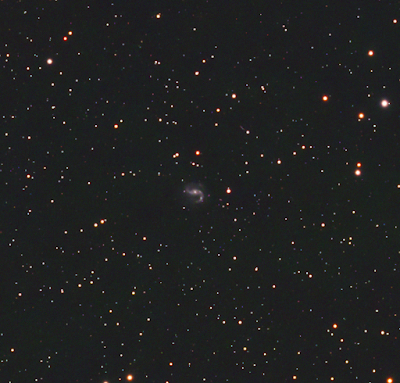On the morning of the 21st July 2025, during an unexpected clear spell, I decided to see if I could get an image of dwarf planet Pluto some two years after I imaged it passing near M75 in the summer of 2023. My intention was to compile an RGB mosaic to include nearby galaxy NGC6907 and additional panels extending towards M75 to show Pluto's movement over a two year period. After taking 45 minutes of Pluto and almost 30 minutes of a panel centred on NGC6907 however, I learned of a supernova that had been discovered five days previously in galaxy NGC 7331 in Pegasus close to the galaxy's core. I therefore halted my plans for the Pluto mosaic in the hope of getting an image of this new star in the sky and slewed my scope towards Pegasus. By that time however, the target was crossing the meridian and nautical twilight was fast approaching, so I could only obtain two 5 minute exposures and one 2 minute exposure of luminance data, but nonetheless was able to clearly identify the supernova close by the core of NGC 7331 as had been reported.
Click on an image to get a closer view
Pluto: 45 minutes of RGB data revealed Pluto as a tri-coloured point of light in the centre of the frame which I cropped and added the symbol for Pluto to the RHS of the dwarf planet for ease of identification.
NGC6907: Despite only having collected some 30 minutes of RGB data on this distant galaxy that lies 120 million light years away in the constellation of Capricorn, this was sufficient to show the galaxy's barred spiral shape.
SN 2025rbs in NGC7331: I processed a single 5 minute luminance sub to reveal the main galaxy and several others in the vicinity which also showed the supernova towards the centre of NGC7331. I cropped the image and submitted it to Astrometry.net in order to annotate it. In order to compare the brightness of the supernova with the galaxy's core and nearby stars, I integrated all useable data comprising 12 minutes of luminance data which I then lightly stretched in Pixinsight. This revealed the supernova to be of comparable brightness to the galaxy's core at around magnitude 10.0. NGC7331 lies some 40 million light years distant.
All data acquired with NINA using a ZWO ASI533MM Pro camera and EFW attached to a Sky-Watcher Esprit 80ED triplet refractor fitted with a field flattener. Data integration and processing was done with PixInsight.
Chris Bowden







No comments:
Post a Comment